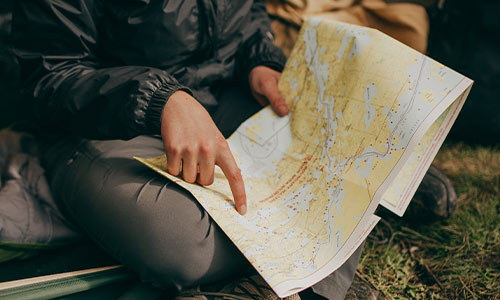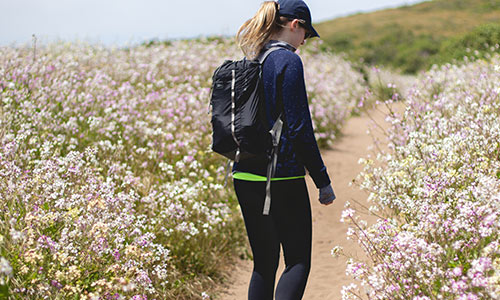The Essential Guide to Hiking Safety: 5 Tips Every Hiker Should Know
Author

Chris shares his passion for cycling, hiking, skiing, and climbing from Buxton, in the Peak District. As a blogger for Outdoor Look, Chris shares outdoor tips and indoor tricks to help you get the most out of your time spent outside. When he's not out adventuring he's making videos or trying to keep up with his 4-year-old son.
Embarking on a hiking expedition is like stepping into a realm of endless wonders, discovering new trails promises breathtaking views and exhilarating challenges. But amidst the thrill of adventure, there is a watchful protector: safety. Yes, safety might not be as glamorous as the panoramic views or adrenaline rushes, but it's the unsung hero that ensures your journey remains a tale of triumph, not tragedy.
The Power of Preparedness
Before setting foot on the trail, thorough preparation is extremely important. Begin by meticulously planning your route, considering factors such as distance, elevation gain, and terrain difficulty. Use reliable mapping tools like GPS devices or apps such as OS Maps to chart your course and identify potential hazards. Research trail conditions, weather forecasts, and any relevant regulations or advisories for your chosen destination. Additionally, inform a trusted friend or family member of your itinerary, including your planned route and estimated return time, as a precautionary measure.

Must-Have Essentials
Packing the appropriate gear can significantly enhance your safety and comfort during a hike. So, what essentials should you carry in your trusty pack? Essentials such as navigation tools (map, compass, or GPS), adequate clothing layers, sturdy footwear, and sufficient water and snacks should always be included. Additionally, carry a well-equipped first aid kit, an emergency shelter (such as a lightweight tent or space blanket), and a signalling device (such as a whistle or mirror) in case of unforeseen circumstances. Tailor your gear selection to the specific demands of the terrain, climate, and duration of your hike to ensure preparedness for any eventuality.
Embracing Limits
While the feeling of reaching a summit or conquering a challenging trail can be enticing, it's essential to recognize and respect your physical capabilities. Be honest with yourself about your fitness level, experience, and skillset, and choose hikes that align with your abilities. Pace yourself appropriately, take breaks as needed, and listen to your body's signals to prevent overexertion and fatigue. Remember that hiking is not a competition but an opportunity for personal enjoyment and growth, so prioritize safety above all else.
Informing Others
Before hitting the trails, inform a trusted friend or family member of your hiking plans. Share details like your intended route, expected duration, and estimated return time. This ensures a safety net in case of emergencies that enables prompt assistance and search efforts if needed. Its important to stay connected during your hike through periodic check-ins, and upon completion, confirming your safe return. By taking this simple yet crucial step, you're prioritizing your safety and ensuring peace of mind for both yourself and your loved ones.

Stick to the Path
In unfamiliar or rugged terrain, staying on marked trails is crucial. Straying off-trail heightens the risk of getting lost or encountering dangerous conditions like steep cliffs or dense vegetation. By following the trail markers, signage, and maps, you minimize accidents and avoid disorientation. Stick to the path, follow the signs, and navigate safely through your adventure. Keeping to marked trails will ensure a smoother journey and reduce the chances of encountering unexpected challenges.
In conclusion, prioritizing safety while hiking is essential for a successful and enjoyable outdoor experience. By following these tips, you can minimize risks, stay prepared for emergencies, and make the most of your time on the trails. Remember to always respect nature, be mindful of your surroundings, and hike responsibly.
-
 Hi Tec Womens Fuse Trail Mid Lightweight Waterpoof Trainers£65.28RRP £75.00 Save Up To £9.72
Hi Tec Womens Fuse Trail Mid Lightweight Waterpoof Trainers£65.28RRP £75.00 Save Up To £9.72
Author

Chris shares his passion for cycling, hiking, skiing, and climbing from Buxton, in the Peak District. As a blogger for Outdoor Look, Chris shares outdoor tips and indoor tricks to help you get the most out of your time spent outside. When he's not out adventuring he's making videos or trying to keep up with his 4-year-old son.
- Speed Up Your Post-Hike Recovery with These 6 Essential Tips
- Cycling through Tranquil Roads and Coastal Views on the Isle of Wight
- Run Smart, Run Strong: Your Guide to Injury-Free Running
- Embrace Biking: Essential Tips for Beginners
- The Ultimate Guide to Gravel Biking: Exploring the Roads Less Travelled
Categories
- Sport (28)
- Product Reviews (3)
- Team Outdoor Look (7)
- Mike Wild (2)
- Mike Payton (2)
- Suse Hammond-Pears (3)
- Snowboarding (12)
- Latest Offers (105)
- Shop Talk (1)
- Competitions (7)
- Walking (413)
- Lifestyle Fashion (8)
- Travel (86)
- Kit Guides (176)
- Workwear Clothing (6)
- Safety Workwear (4)
- Health/Fitness (289)
- Skiing (91)
- Great Outdoors (1316)
- Cycling (92)
- January 2025
- December 2024
- November 2024
- October 2024
- September 2024
- August 2024
- July 2024
- June 2024
- May 2024
- April 2024
- March 2024
- February 2024
- January 2024
- December 2023
- November 2023
- October 2023
- September 2023
- August 2023
- July 2023
- June 2023
- May 2023
- April 2023
- March 2023
- February 2023
- January 2023
- December 2022
- November 2022
- October 2022
- September 2022
- August 2022
- July 2022
- June 2022
- May 2022
- April 2022
- March 2022
- February 2022
- January 2022
- December 2021
- November 2021
- October 2021
- September 2021
- August 2021
- July 2021
- June 2021
- May 2021
- April 2021
- March 2021
- February 2021
- January 2021
- December 2020
- November 2020
- October 2020
- September 2020
- August 2020
- July 2020
- June 2020
- May 2020
- April 2020
- March 2020
- February 2020
- January 2020
- December 2019
- November 2019
- October 2019
- September 2019
- August 2019
- July 2019
- June 2019
- May 2019
- April 2019
- March 2019
- February 2019
- January 2019
- December 2018
- November 2018
- October 2018
- September 2018
- August 2018
- July 2018
- June 2018
- May 2018
- April 2018
- March 2018
- February 2018
- January 2018
- December 2017
- November 2017
- October 2017
- September 2017
- August 2017
- July 2017
- June 2017
- May 2017
- April 2017
- March 2017
- February 2017
- January 2017
- December 2016
- November 2016
- October 2016
- September 2016
- August 2016
- July 2016
- June 2016
- May 2016
- April 2016
- March 2016
- February 2016
- January 2016
- December 2015
- November 2015
- October 2015
- September 2015
- August 2015
- July 2015
- June 2015
- May 2015
- April 2015
- March 2015
- February 2015
- January 2015
- December 2014
- November 2014
- October 2014
- September 2014
- August 2014
- July 2014
- June 2014
- May 2014
- April 2014
- March 2014
- February 2014
- January 2014
- December 2013
- November 2013
- October 2013
- September 2013
- August 2013
- July 2013
- June 2013
- May 2013
- April 2013
- March 2013
- February 2013
- January 2013
- December 2012
- November 2012
- October 2012
- September 2012
- August 2012
- July 2012
- June 2012
- May 2012
- April 2012
- March 2012
- February 2012
- January 2012
- December 2011
- November 2011
- October 2011
- September 2011
- August 2011
- May 2010
- April 2010
- March 2010
- February 2010
- January 2010
- November 2009
- October 2009
- September 2009


Submit a Comment